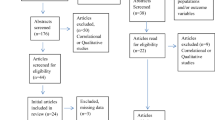Abstract
High test-anxióus college students (N =78) were placed in one of four treatment conditions or a no-treatment group. Treatments included (1) training in an emotional coping skill of differential relaxation, (2) training in a cognitive coping skill of replacing anxiety-creating, task-irrelevant self-statements with adaptive self-statements, (3) a combined cognitive and emotional treatment, and (4) an attention placebo condition. All treatments included theoretical explanations, role-played tests, and homework assignments. Self-report, performance, and physiological measures were administered pre- and posttreatment. The self-report measures showed the only significant differences between conditions. The Cognitive and Cognitive +Emotional treatments showed consistent improvement on all but one of the self-report measures. A 5-week follow-up generally indicated that self report changes were maintained.
Similar content being viewed by others
Reference Note
Wine, J. D.Test anxiety and self-attention. Paper presented at the meeting of the American Psychological Association, New Orleans, August 1974.
References
Alpert, R., & Haber, R. M. Anxiety in academic achievement situations.Journal of Abnormal and Social Psychology 1960,61 207–215.
Doris, J., & Sarason, S. Test anxiety and blame assignment in a failure situation.Journal of Abnormal and Social Psychology 1955,50 335–338.
Ganzer, V. H. Effects of audience presence and test anxiety on learning and retention in a serial learning situation.Journal of Personality and Social Psychology 1968,8 194–199.
Goldfried, M. R. Systematic desensitization as training in self-control.Journal of Consulting and Clinical Psychology 1971,37 228–234.
Liebert, R. M., & Morris, L. W. Cognitive and emotional components of test anxiety: A distinction and some initial data.Psychological Reports 1967,20 975–978.
Little, S., & Jackson, B. The treatment of test anxiety through attentional and relaxation training.Psychotherapy: Theory, Research and Practice 1974,11 175–178.
McNair, D. M., Droppleman, L. F., & Kussman, M. Finger sweat print tape bands.Psychophysiology 1972,39 370–380.
Meichenbaum, D. H. Cognitive modification of test anxious college students.Journal of Consulting and Clinical Psychology 1972,39 370–380.
Meichenbaum, D., & Turk, D. The cognitive-behavioral management of anxiety, anger, and pain. In P. O. Davidson (Ed.),The behavioral management of anxiety, depression and pain. New York: Brunner/Mazel, 1976.
Morris, L. W., & Liebert, R. M. Effects of anxiety on timed and untimed intelligence tests: Another look.Journal of Consulting and Clinical Psychology. 1969,33 240–244.
Morris, L. W., & Liebert, R. M. Relationship of cognitive and emotional components of test anxiety to physiological arousal and academic performance.Journal of Consulting and Clinical Psychology 1970,35 332–337.
Richardson, F. C. Anxiety management training: A multimodal approach. In A. A. Lazarus (Ed.),Multimodal behavior therapy. New York: Springer, 1976.
Richardson, F. C., O'Neil,, H. F., Whitmore, S., & Judd, W. A. Factor analysis of the test anxiety scale and evidence concerning the components of test anxiety.Journal of Consulting and Clinical Psychology 1977,45 704–705.
Sarason, I. G. Experimental approaches to test anxiety: Attention and the uses of information. In C. D. Spielberger (Ed.),Anxiety: Current trends in theory and research (Vol. 2). New York: Academic Press, 1972.
Sarason, I. G. Test anxiety and cognitive modeling.Journal of Personality and Social Psychology 1973,28 58–61.
Sarason, I. G. Test anxiety and the self-disclosing coping model.Journal of Consulting and Clinical Psychology 1975,43 148–153.
Southard, L. D., & Katahn, M. The correlation between self-reported and mechanically-recorded pulse rates.Psychonomic Science 1967,8 343–344.
Wine, J. D. Test anxiety and direction of attention.Psychological Bulletin 1971,76 92–104.
Author information
Authors and Affiliations
Additional information
This study is based on the doctoral dissertation of the first author. Thanks are given to the dissertation committee at the University of Texas at Austin, which included Michael D. Spiegler, Paul Blaney, Robert Helmreich, George Parker, and Frank Richardson. Special thanks go to Jerry Marshall and Bill Kirkpatrick for serving as therapists.
Rights and permissions
About this article
Cite this article
Cooley, E.J., Spiegler, M.D. Cognitive versus emotional coping responses as alternatives to test anxiety. Cogn Ther Res 4, 159–166 (1980). https://doi.org/10.1007/BF01173647
Issue Date:
DOI: https://doi.org/10.1007/BF01173647




